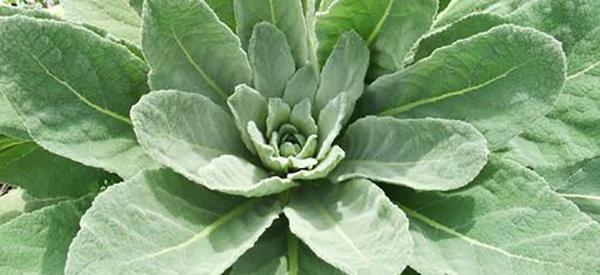
Mullein
Mullein (Verbascum thapsus), also known as great mullein or common mullein is a native biennial plant of Europe, northern Africa, and Asia. It has been used in herbal medicine for at least centuries. It is a tough and drought tolerant, sometimes weedy, species of mullein.
Mullein’s name originates from an old French word that means soft. The soft yet durable fuzzy chartreuse leaves even make great emergency toilet paper. In fact, one of the mullein’s many common names is Velvet Plant. The mullein we are familiar with is part of a genus of plants called Verbascum. Verbascum has over 200 species.
The Verbascum thapsus species has many variations throughout its native homelands. Interestingly, the great mullein or common mullein, Verbascum Thapsus, familiar in North American has less variation. This may be attributed to Mullein’s seed longevity and the presumption that many of the North American species may have originated from a smaller gene pool that arrived with early settlers of North America.
The History of Mullein
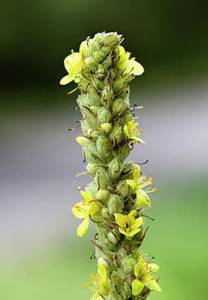 Mullein’s arrival to North America dates back to early in the 18th century. Its ability to spread had some botanists mistakenly thinking Mullein was a native plant. This is because of its ease of spreading, seemingly arriving ahead of the settlers who brought it!
Mullein’s arrival to North America dates back to early in the 18th century. Its ability to spread had some botanists mistakenly thinking Mullein was a native plant. This is because of its ease of spreading, seemingly arriving ahead of the settlers who brought it!
Mullein has been used in traditional medicine for at least 2000 years. It was first recommended in De Materia Medica by Dioscorides, a Greek physician, pharmacologist, and botanist.
Roman soldiers, among other cultures, used mullein stalks dipped in grease or wax as torches. Additionally, a yellow dye may be obtained by boiling the yellow mullein flowers in water.
Its medicinal potential was taken up quickly by First Nation people of North America as an aid to pulmonary illnesses. Also, mullein root was powdered and made into poultices for wound care, rashes, and infection by the Zuni people of New Mexico. Mullein leaves were also used to line shoes to help keep feet warm.
Where the Plant is Found
Mullein is found throughout North America including Canada, Mexico, and all US states including Alaska and Hawaii. Moreover, it grows at elevations from sea level to up to 10,000 feet. Mullein prefers disturbed low-quality sites that are well-draining. Full sun is where mullein is found. It is intolerant of shade. Look for mullein in natural areas such as dry pastures, meadows, and open forest areas. It is also common in disturbed areas such as road cuts and edges, along railways, and industrial areas. Not exclusively but in general, mullein is found in gravelly and sandy soil situations.
How to Identify Mullein
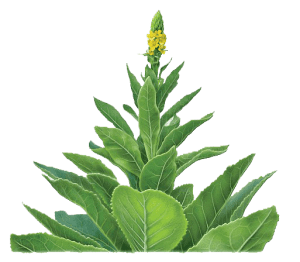 Mullein is a biennial plant which means it flowers in its second season. In its first season, mullein forms a basal rosette of silvery green leaves. In its second season, the tall, up to 8 feet, flower stalk grows from the center of the basal rosette. Often, mullein is found growing in colonies.
Mullein is a biennial plant which means it flowers in its second season. In its first season, mullein forms a basal rosette of silvery green leaves. In its second season, the tall, up to 8 feet, flower stalk grows from the center of the basal rosette. Often, mullein is found growing in colonies.
- Shape: In the first year, mullein forms a basal rosette 1 to 2 feet across. In the second season, the tall club-like flower stalk bolts up 6 to 8 feet.
- Leaves: Leaves are large and fuzzy. They grow up to 15 inches long and 5 inches wide. Leaves are silvery green or chartreuse in color. They are oval and widest at the base, becoming narrower ending in a blunt or slightly pointed tip. Leaves attach alternately with short stems at the base of the plant. They are stemless as they grow up the stalk.

- Flower: The upper 2 feet of the flower stalk is covered in densely packed yellow flowers that are ¾ inches across. Only a few flowers are open at any one time. Flowers have five yellow petals and five orange-tipped stamens.
- Stem: The single club-like stalk rises from the center of the basal rosette of leaves. The stem is also covered in fine hairs.
- Fruit & Seeds: The stalk with seed capsules may persist through winter. Each flower becomes a 2-chamber capsule, each containing dozens of seeds. In fact, a single plant may produce 200 to 300 seed capsules with up to 600 to 800 seeds. This means that just one plant may produce as many as 100,000 to 240,000 seeds!
How to Grow Mullein
Mullein makes attractive plants in the landscape. Interestingly, there are many ornamental varieties to choose from. They are also a popular choice in emergency gardens, herbal medicine gardens, and food forests. Mulleins need a lot of room to grow and prefer sunny, dry areas.
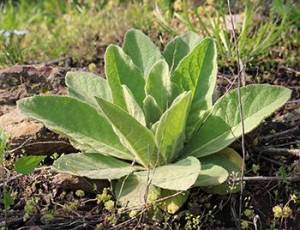
Their seeds may persist for many years in the soil. In fact, viable mullein seed has been found that is hundreds of years old. For this reason, it makes sense to choose an area for mullein where it may naturalize and form an attractive and beneficial colony of plants. It is interesting to note, plants require a dormancy period and exposure to cold temperatures to bloom.
To grow mullein, collect seeds in fall from dried flower stalks. Scatter seeds liberally in an area that is in full sun with rocky, gravelly, or sandy soil. In spring, check the area for successful first-year plants.
Related: The 10 Medicinal Seeds You Should Plant for a Complete Backyard Pharmacy (Video)
How to Harvest This Plant
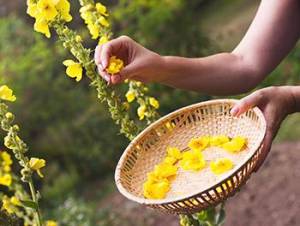
- Leaves: Leaves are best picked from young plants in spring during the early parts of the day. The leaves of first-year plants are excellent, in my opinion. Some folks prefer harvesting leaves from second-year plants just before or during the plant’s bloom period.
- Flowers: The flowers of mullein can be collected from a large area or over several days. This is because only a few flowers on each plant are open at the same time.
They are best picked just as they are freshly opened during the early part of the day.
Related: 400 Wild Plants That You Can Forage For (Video)
What Mullein Is Good For & The Natural Remedies Made from It
- Mullein has been used in the treatment of many respiratory and pulmonary issues. These include asthma, bronchitis, congestion, tuberculosis, and spasmodic coughs.
- It has also been used to treat many gastrointestinal issues such as diarrhea.
- Similarly, mullein has been used to treat inflammation and pain such as gout, and migraine.
- Interestingly, mullein also has many benefits for issues of the skin. Particularly, mullein is helpful for wounds, burns, frostbite, infections, and bruises.
- Mullein, along with other medicinal herbs, has been used to help naturally treat ear infections in children.
- Mullein contains many active compounds which may contribute to its beneficial effects. These include saponins which may help pain and inflammation. Additionally, other mullein active compounds are flavonoids, phenylethanoids, and iridoids which are antioxidative and anti-inflammatory.
- Most interestingly, mullein has shown incredible antibacterial activity. A study of mullein extracts showed inhibition in certain bacteria. These included Klebsiella pneumonia, Staphylococcus aureus, Staphylococcus epidermidis, and Escherichia coli. Similarly, mullein extract showed inhibition of certain types of tumors.
The plant itself also has many uses. The club-like flower stalk can be used as a torch. Similarly, the dried felt-like leaves make excellent tinder. The flowers can be boiled to make a yellow dye. This dye can be altered to make brown and green dyes as well.
Related: How To Naturally Dye Your Everyday Items
It is useful in the landscape as it provides food and shelter for many pollinating insects. They are visited by many birds and butterflies as well.
There are many natural remedies that can be made from mullein.
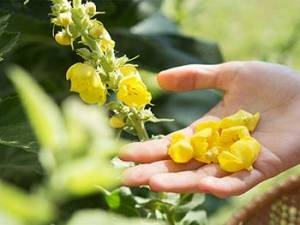
- Mullein extracts can be made in water. These are also available through health food stores and online.
- A tincture made by soaking mullein leaves and flowers in alcohol is another way to extract the beneficial compounds of this useful plant. (available in the Apothecary)
- Mullein oil is excellent for treating skin afflictions. Moreover, it has been used as a safe and natural treatment for ear infections in children. The oil can be made by hot processing mullein leaves and flowers in a carrier oil such as olive oil.

- Alternatively, mullein oil can be made by a slow, cold infusion process. This would entail using fresh or dried mullein leaves and flowers and infusing them in a carrier oil at room temperature.
- Mullein Tea is available commercially. Below, we will share a DIY recipe for making dried mullein tea. Moreover, this dried mullein tea can also be used to make any number of the above recipes.
What Parts of The Plant Are Used in Remedies?
Although there are some historical uses of the roots and seeds, most notably, the leaves and flowers have the most medicinal uses. The leaves and flowers are the most valued plant parts due to their antiseptic, anti-inflammatory, expectorant, astringent, and antispasmodic properties.
A DIY Mullein Tea Recipe
In this recipe, we will collect fresh young leaves and prepare them for storage. This is the first step to using the many beneficial attributes of mullein. The dried leaves can then be used to make mullein tea as shown below. The dried leaves may also be used to make extracts, tinctures, and oils as described above. Alternatively, you might use fresh leaves and flowers to make other mullein products. As they are fresh, they would need to be prepared or processed much sooner after harvest.
Method
Collect young mullein leaves from first- or second-year plants in spring.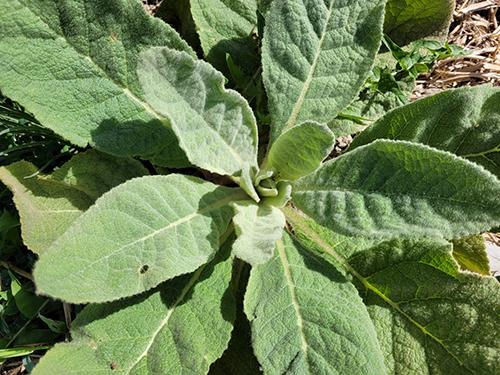
The best time to do this is early in the day while it is still cool. If necessary, gently wash the leaves of any debris.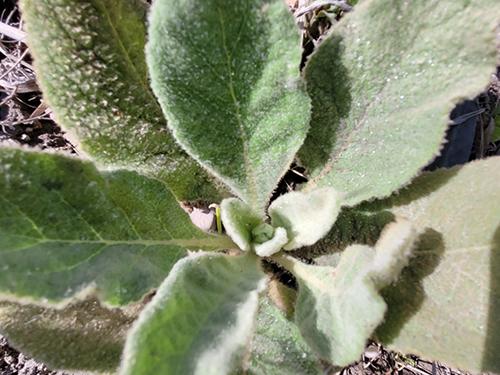
Dry the mullein leaves. Mullein leaves are dense and strong. They require significant time to dry. They can be dried using a dehydrator or a very low-temperature oven. Mullein is susceptible to losing its lovely silvery-green color when dried. Often dried mullein is a dull rusty brown.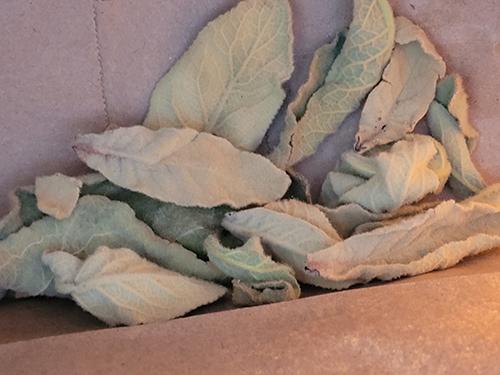
To avoid this, I dry the mullein in a paper bag to limit the exposure to light which fades and changes color. I hang the bag in a protected area with excellent air circulation. A great place might be on a porch, under a deck, or in a barn. Check the bag regularly and toss the leaves slightly. This will help the leaves dry more evenly.
When the leaves are fully dry, they will be rather stiff but not brittle. Surprisingly, they are durable even when dried.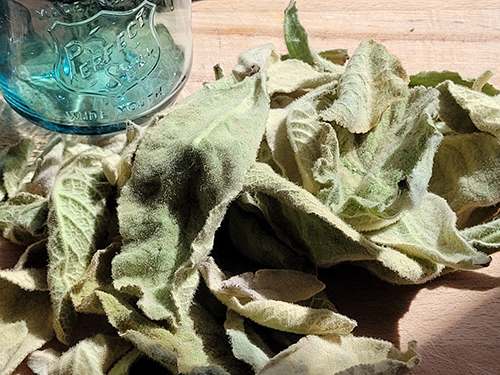
I tear them apart by hand as they are difficult to chop up with a knife. I put them in an herb chopper or food processor to break up the leaves even further.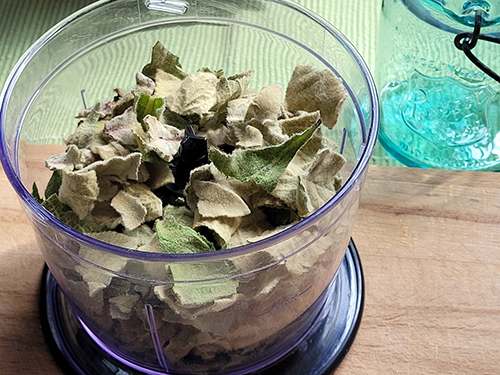
Once the leaves are broken up to a reasonable size for making tea, they are perfect to put in a glass jar for long-term storage.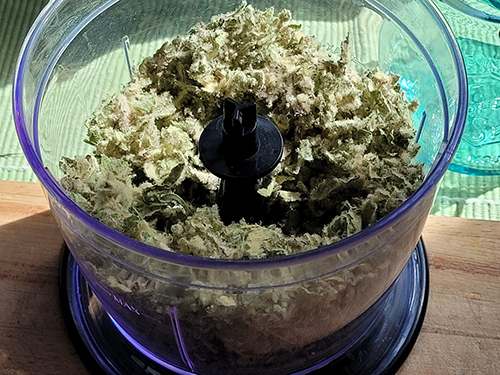
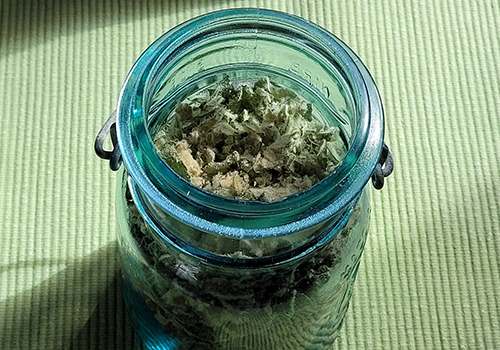
Mullein Tea
To make the perfect cup of mullein tea, first, boil a cup of high-quality water. Next, place 1 teaspoon of dried mullein leaves in a cup and cover with boiling water. Allow steeping for 10 to 15 minutes.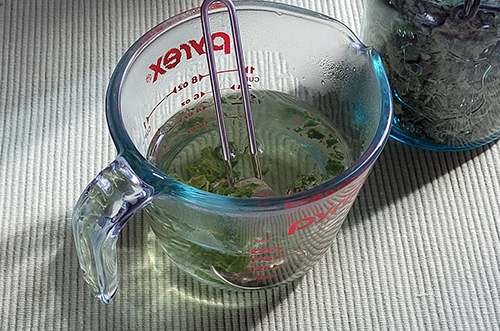
*Important Step! Filter the steeped mullein tea through an exceptionally fine mesh or coffee filter. In this way, the fine hairs will be removed from the tea. The fine hairs of mullein leaves can irritate the airway. This, of course, is contraindicated if the tea is to aid respiratory or pulmonary systems.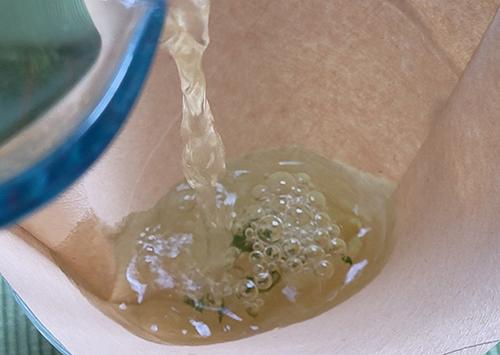
Drink tea as is or add a sweetener of your choice to taste.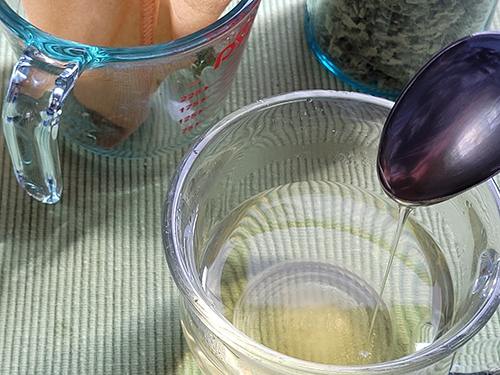
An Excellent Companion to This Tea: Throw a couple of thyme leaves in with the mullein while it is steeping. Delicious!
Potential Uses of Dried Mullein Leaves
Most of the mullein leaves dried here will be used as an evening tea to help clear the airway and strengthen the respiratory system.
Dried mullein leaves can also be used to make an oil infusion. Using dried leaves versus fresh leaves to make oil infusions is often recommended. The lower moisture content makes a safer infused oil that has a longer shelf life. Mullein infused oil can be used as a topical treatment for wounds and skin irritations. It may also help relieve symptoms of earache.
Similarly, dried mullein leaves can be used to make extracts and tinctures. These can be used as supplements or as topical treatments.
Dosage
Currently, there is not a lot of evidence to support specific dosages of Mullein products.
How To Preserve This Plant
Mullein can be dried as described above. Extracts from the fresh leaves and flowers can also be made in oil, alcohol, or water to preserve this beneficial plant.
What Plants Resemble Plant?
Mullein
| Feature | Mullein (Verbascum thapsus) | Lamb’s Ear (Stachys byzantine) |
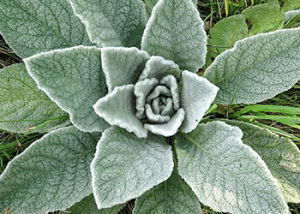 |
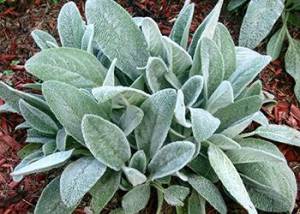 |
|
| Size & Shape | A 1- to 2-foot basal rosette. 4 to 6 foot single flowering stalk. | Low uniform mat. |
| Leaves | 6- to 15-inch-long oval leaves. Gray-green and very fuzzy. | 2- to 6-inch-long tongue-shaped leaves. Blue-green leaves with white woolly hairs. |
| Flowers | 4- to 6-foot single flower spike covered in densely packed yellow five-petaled flowers | 12 to 18 inch flower spikes bloom in summer with small purple flowers. |
Warnings And Cautions
Mullein is considered safe for internal use. All preparations need to be diligently filtered to ensure the removal of fine hairs. Of course, with any new ingredient do a small skin test prior to ingestion or liberal topical use. Any reaction such as itchiness or hives may be an indication of sensitivity. Practice caution with topical use, particularly for people who suffer from sensitivities and allergies.
To reduce and avoid any contraindications or medicine interactions, check with your healthcare provider before starting new herbal remedies.
You may also like:
Similar to Morphine: The Best Natural Painkiller that Grows in Your Backyard (Video)
25 Medicinal Plants You Can Forage Right Now
How to Treat an Asthma Attack Naturally When You Don’t Have an Inhaler

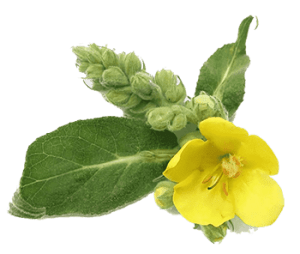
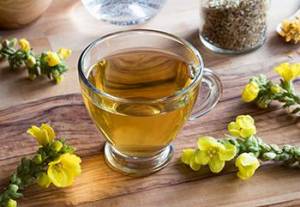
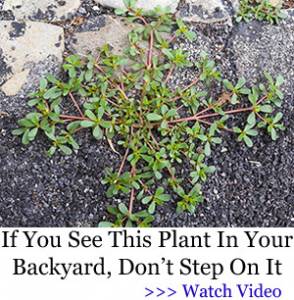
I love Mullein ! I use it for teas and smoke it. I add mint leaves for taste. Question: Is there any problem adding Oregano and or Catnip to smoking mixture ?
Hi Steve,
Thank you for your interest in our work.
Yes, you can add Catnip and Oregano to your mixture.
Smoking catnip may not be the primary use of this herb, but it can be smoked. It works as a slight sedative, providing a sense of calm and tranquility.
Be aware that large doses are reported to cause headaches, nausea, or dizziness. Its sedative effects may mean it is not suitable for use before driving or operating heavy machinery.
Oregano is an exceptionally flexible spice. You can smoke oregano mixed with other herbal blends or tobacco. Smoking oregano gives you a new mint-like fragrance and herbal taste.
I hope this helps!
You can also check out the article below for more information about the herbs that can be smoked:
https://thelostherbs.com/healing-herbs-you-can-smoke/
Many blessings and good health!
Thank you so much for the link on smokable herbs. Can you suggest a length of time it’s safe to take a mullein tincture. Dad wants to continue taking daily. (After using these to treat a cold) He feels it improving his health. He also takes oregano oil and garlic oil along with the mullein tincture. One dropper full each 3x daily. He has COPD and congestive heart failure. Only other medication is a loop diuretic and a baby aspirin. We will be switching the diuretic to a dandelion tincture this summer. All advice or links are appreciated. Thanks for your time.
I love mulein… another purpose not mentioned, highly illegal to do however important knowledge for survival situation ONLY is the seeds can be ground to a powder and when sprinkled into water where fish are, it will stun thr fish and they float to the top of the water. This is illegal for many reasons as it can completely deplete the fish, which can cause major environmental impacts. However, this is also knowledge to be lost to time I thought was fascinating
Hi Megan, Interesting bit of knowledge you’ve shared. So, just like foraging for plants, medicines, gathering food ought as you say not to “deplete” the precious fish. So, I’m wondering, since the fish are stunned, does this mean, that any not removed from the water would still live? Or is that a permanent situation for the whole bunch (or school)? Thanks (may none ever be in that dire situation).
It only stuns for a brief time. Fish must be killed before processing.
The saponins are harmful to the fish’s gills. Compare the sensation to shooting dish-soap up your nose–not pleasant, and it would have after-effects. The severity of damage and the effectiveness of the stun would rise together with the dose. A fish might recover afterward if the damage was not too great and a predator didn’t take advantage of their weakness.
An easier plant to use to accomplish this kind of fish harvest with saponin would be the Kentucky Coffee tree. The tree creates pods with large, hard seeds inside, and in autumn, when the pods are fully ripened and brown, the interior is filled with a bright green goop surrounding the seeds. That goop is easy to harvest and then dissolve into a small amount of water, before pouring into a pond for a fish-kill. (Also, the goop is just sort of fascinating. Back when there were megafauna in North America, the sweet-tasting goop was the tempting food that got mammoths to help distribute the seeds.)
Enjoyed this info.
Hi Roger,
Thank you for your comment.
I’m glad to hear that you enjoyed this.
Many blessings and good health!
Why do some of the mullein stalks take a couple of 90-degree turns at the very top when they grow? We have these everywhere, and some simply grow straight up, and others make two turns on the way up. I have been noticing this a lot this year.
I heard that smoking mullein can help stop tobacco addiction? Any truth to this?
I did just that nearly 50 years ago..it helped alot as it gave you something to smoke as you were trying to get rid of the habit. I also mixed it with mint for a menthol taste sometimes. but was not sure how good smoking mint is for the lungs.
Thanks Elaine. That’;s what I’m trying to get an answer for. I’m using mint, Oregano and sometimes, Catnip and Sage. There has been no response from the Editor or author on the plausibility of these herbs for smoking.
Wow. We have mullein growing left, right and centre in gardens and fields in Ireland….. I shall start harvesting. Thank you
Hi Cathy,
Thank you for your comment.
I’m happy to hear that you have mullein growing all around you.
Many blessings and good health!
Curious klesieba pneumonia infection and mullein I’d like to learn more
Is there a timing – stage of growth – when mullein leaves are most effective in a tea for respiratory difficulties?
Is there a timing – stage of growth – when mullein leaves are most effective in a tea for respiratory difficulties?
Oh just found this:
‘Collect young mullein leaves from first- or second-year plants in spring’
So I’ll wait till next Spring 🙂
Mullein is easy enough to identify. It reminds me of a psychotic corn stalk. Its always been worth the effort to make tea.
hello, where can I find mullein seeds to grow. I am in Camden nj and I would like to grow some. I do purchase the dry version of the leaves, but would like to expand my garden. Also is smoking this herb as well as others better than smoking actual black and milds or cigarettes? Trying to find something for my oldest son. He smokes…
Thank you!
I planted mullein for the first time this year & am just learning. I’ve missed the window to harvest it in the spring & to get the new leaves. Mine has large leaves. Is there any value/usage for it at this stage? Or do I really just need to wait until next year. Is it a potency issue? Trying to understand & want to do the right thing but also don’t want to lose out on a resource if it still has value now. Thanks!
JO,
The “best” time to harvest Mullein, first or second year, is in the spring, early morning. However, I have harvested after the first frost and the leaves still worked quite well.
Keep in mind that the later you harvest, the more damage and degradation the leaves will have.
When harvesting in the spring, take no more than 1/3 of the available leaves/flowers. This leaves keeps the “injury” low enough to where the plant can easily recover and leaves the plant with enough foliage to continue growing (photosynthesis).
I recommend air drying, away from sunlight.
Hope this helps.